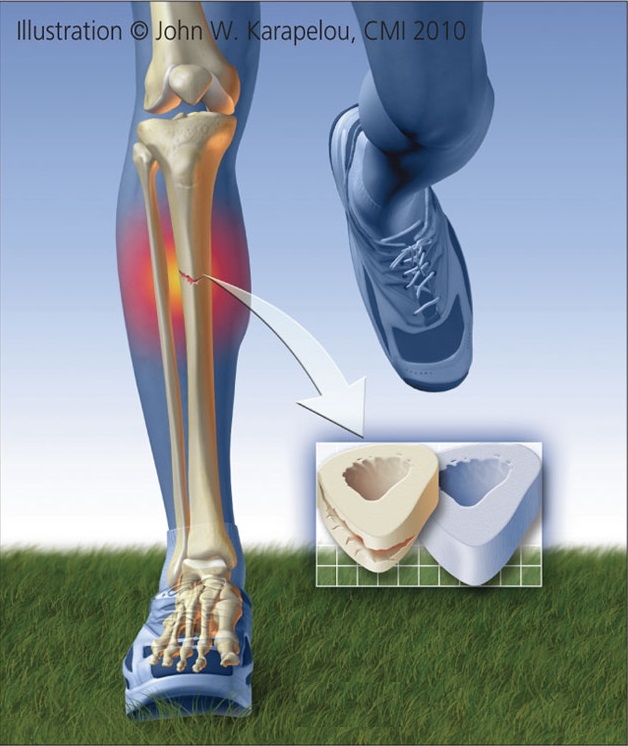Stress fractures and bone stress

STRESS FRACTURES and BONE STRESS
What is a Stress Fracture?
A stress fracture is a hairline crack within the bone. Unlike a complete fracture the break is not displaced and does not go across the whole bone. Stress Fractures are usually caused by chronic repetitive stress rather than a fracture event like a fall. 50% of stress fractures in runners are in the shin bone (Tibia) with the bones in the forefoot before the toes (metatarsals) and the heel bone (calcaneus) also common.
What are the Symptoms?
Stress fractures are often preceded by progressing bone stress over a period of a few weeks. Bone pain can be intense but usually is described as aching. When running it hurts on impact and gets worse rather than warming up. There is localised severe pain on palpation commonly with swelling over the bone. It hurts to hop but often is fine walking. In some cases there will be pain at night waking you from sleep.
What Causes Stress Fractures?
The most common cause of stress fractures is overtraining. Most runners have increased or changed their training 5 to 6 weeks prior to when pain began. The increased training stimulates the body to try and adapt and grow stronger to deal with the new training load. The bone responds by bone turnover involving reabsorption of weak or damaged bone and the laying down of new bone. While the bone is remodelling it is susceptible to a stress fracture if the training is continued at a high level. This is because bone formation can not keep up with bone absorption. Low bone density can increase the likelihood of a fracture as well as running in worn shoes, excessive downhill running and overstriding. Rigid feet have an increased risk of stress fractures compared to flexible feet.
What Do I Do?
If you suspect you may have a stress fracture you should have it checked ASAP by a Podiatrist. Clinical diagnosis with history and palpation can identify a stress fracture in most cases however you may need to have an MRI to be definitive. Bone edema from a stress fracture shows up as a white patch within the body of the bone on a T2. Normal X-rays will rarely show a stress fracture and then only after 2-3 weeks.
Treatment involves complete rest from running. Early return before it has healed can restart the rehab time. If you continue to run with a stress fracture it can then lead to a complete fracture with much more severe complications.
When can I get back running?
The size of the bone determines the time required for healing. It can be as little as 4 weeks for metatarsals to 12 weeks for femurs. You can do any cross training that does not hurt while it is healing. After a stress fracture has healed it will be stronger for up to six months with less chance of another fracture in the same place. A rehab return to training program will then be needed to make sure you do not pick up another injury. It is worth checking out your biomechanics, footwear and training at the intraining Running Injury Clinic to see what might have caused the injury in the first place. That way you can reduce your future stress fracture risk. Treatment to reduce the risk of another fracture can involve changing your running technique, finding the right shoe for your biomechanics and customising your shoe with orthotics.
 Common TYPES of Stress Fractures?
Common TYPES of Stress Fractures?
• A stress fracture of the HIP (Pubic Ramus) usually starts as groin pain and can be difficult to differentiate from a muscle strain in the groin. Sometimes the pain refers into the buttocks. This is the most dangerous type of stress fracture if it goes on to a complete fracture because of the complex network of muscles around the hip.
• A stress fracture of the Thigh Bone (Femur) is rare in runners. Because it is such a large bone it can take up to 12 weeks for the bone to heal. Fractures can occur at the neck or shaft of the femur.
• Stress Fracture of the Shin (Tibia) is the most common Stress Fracture in runners. It usually starts with aching shins. Runners who continue to run with shin pain may lead to a stress fracture. The most frequent location is on the inside border of the bone of the lower leg. Fractures of the front border of the bone take longer to heal because standing causes tension rather than compression of the fracture line. Fractures of the posterior border are often mistaken for calf strains but also will take longer to heal. The other lower leg bone (Fibula) can also get a stress fracture although it is from muscle tension rather than impact forces.
• Stress Fracture of the Heel (Calcaneus) was the first type of Stress fracture discovered by a French army physician in the 1900’s. It can be mistaken for plantar fasciitis but the bone will hurt to squeeze on both sides at the same time. Hurts on impact and runners will often avoid heel striking when running.
• Stress Fracture of the Metatarsals are the quickest to heal because they are the thinnest bone. The second metatarsal is the most frequent one damaged because it is the longest metatarsal and takes the most load. Swelling can extend across the top of the whole forefoot.
Keen to learn more about running injuries? Check out our monthly ‘From the Sole‘ newsletter, written by intraining Running Injury Clinic podiatrists, physiotherapist and dietitian.
